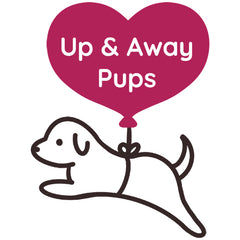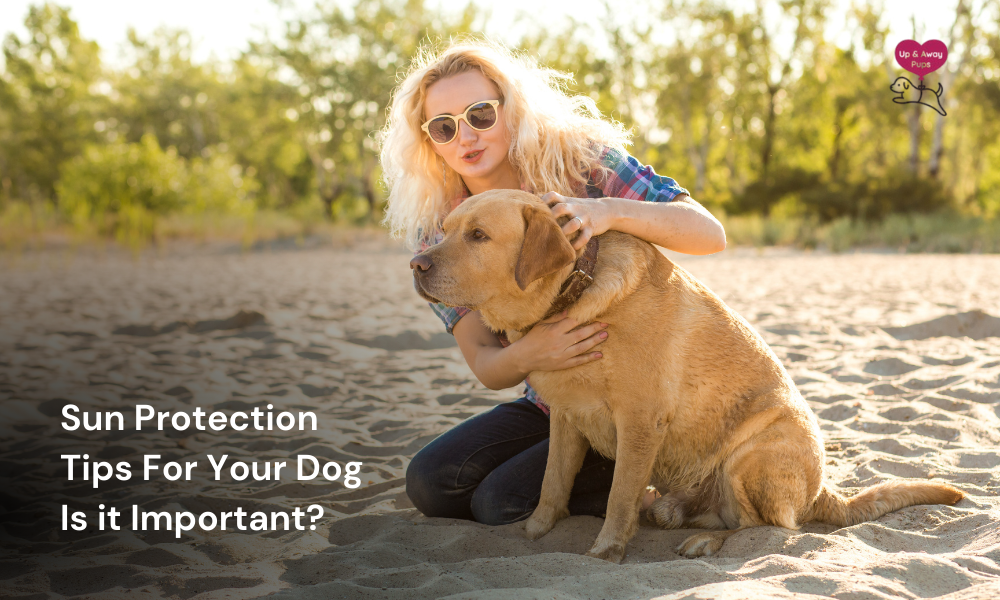Sun Protection Tips For Your Dog. Is it Important?
Just like humans, dogs are vulnerable to sun exposure, which can lead to sunburn, dehydration, heatstroke, and even skin cancer. Breeds with light-colored or short coats are at higher risk. Learn essential sun protection tips, including using dog-safe sunscreen, providing shade, and ensuring proper hydration. Discover how to keep your pup safe and comfortable while enjoying outdoor adventures. Read our complete guide.
If you are a dog owner, the approaching summer makes it essential to take proper care of your furry companion. One of the common aspects of your dog's health is offering adequate sun protection. Similar to every human, dogs are prone to suffer from the harmful adverse impacts of UV rays. If you fail to take the right precautions, your dog is at risk of dehydration, sunburn, and serious health issues such as skin cancer or heatstroke. In our blog, we will highlight the real essence of sun protection for dogs and offer practical tips to help protect their health, especially while spending time outdoors under the sun.
Understanding the Risks of Sun Exposure for Dogs
Dogs mainly breed similar to Bichpoo and are prone to several risks, like what humans suffer from sun exposure. Although dogs ' fur offers good protection, it does not offer a complete shield. UV rays often cause numerous health issues, including sunburn and skin cancer, as highlighted in the effect of sun exposure on animals, and we’ll explore these issues further below:
• Sunburn: Dogs with light-colored fur or thin coats are more at risk of sunburn. The exposed areas of the body, such as the ears, nose, and belly, are particularly at risk.
• Skin Cancer: Like humans, dogs' prolonged exposure to UV rays increases their chances of developing skin cancer. Breeds with light-colored fur or short coats, such as Maltese, are at a greater risk.
• Heatstroke: Dogs are often prone to overheating due to their lack of sweat as profusely as humans. Sun exposure exacerbates the risk of heatstroke which proves fatal whenever not addressed immediately.
• Dehydration: Your dogs are prone to rapid dehydration under heat if they do not have sufficient water. Prolonged sun exposure maximizes the need for proper hydration, which is the key to overcoming heat-induced illnesses.
Why Sun Protection Matters for Your Dog
Dogs failing to hide under shade or take proper measures to stay safeguarded against sun exposure puts them at risk of the harmful impacts of the UV rays, including heat rash. Numerous factors lead to this greater risk, such as:
• Fur Coverage: Although a few dogs have thicker coats, others have shorter or thinner fur that does not offer any protection from harmful UV radiation. So, can dogs get sunburned? The answer is "Yes," as dogs with less exposed skin or fur are prone to the risk of getting sunburn.
• Breed Sensitivity: Breeds with light-colored fur or shorter coats are prone to sun-related damage. Small dog breeds like Maltese have less natural protection from the sun due to their fur or skin.
• Age and Health: Puppies or older dogs with pre-existing health issues such as skin conditions or allergies are at greater risk of sun-induced damage. Their bodies cannot tolerate sun exposure, unlike those of middle-aged, healthier dogs.
How to Protect Dogs From the Sun
Knowing the associated risks makes dog sunburn prevention important, similar to getting rid of ticks that harm your furry companion. So, let's look at a few practical tips for safeguarding your furry companion from the sun.
Limit Exposure During Peak Sun Hours
The sun shines the strongest between the time 10 am to 4 pm. It is during these hours that UV rates are highly intense. This turns the exposure to direct sunlight that puts your dog at risk. Numerous pet owners wonder do dogs need sunscreen at these times, absolutely mainly for breeds with short hair or light-colored coats. Try avoiding any outdoor activities during these peak hours. If your dog adores their outdoor playtime, consider playing or taking them for walks in the early mornings or late evenings whenever the sun is cooler. These form the ideal times to try out outdoor adventures without causing any unwanted sun damage.
Provide Adequate Shade
Whenever you are outdoors with your dog, ensure to offer them proper shade where they can rest and cool off. Shade is the key to reducing the chances of heatstroke or sunburn, whether under a tree, an umbrella, or a canopy. Try opting for dog-friendly outdoor shades like trips to the beach or a park or using a pop-up tent as a summer safety for dogs. It is in this manner that your dog enjoys being outdoors without prolonged sun exposure. Ensure to keep your dog cooler and shade, as it reduces the chances of heat exhaustion or dehydration.
Use Dog-Specific Sunscreen
Not all sunscreens are made for your dog's safety. Human sunscreens consist of hazardous chemicals such as zinc oxide, which proves toxic for dogs whenever ingested. Search for dog-friendly sunscreen, as these are free from harmful ingredients. Apply sunscreen on areas that have prolonged exposure to the sun, like the belly, nose, and ears, and in areas with thinner fur. Ensure to reapply the sunscreen every couple of hours, mainly if your dog is playing or swimming. Buy the sunscreen product with added moisturizers. It helps in soothing the skin of your dog mainly when they are prone to irritation or dryness.
Avoid Hot Pavement
During the sunny days, pavements turn highly hot, mainly across the urban areas. Dogs with paw sensitivity suffer from blisters or burns if they are walking on hot pavement for a prolonged duration. Protecting dog paws from hot pavement is important, so be sure to check the pavement's temperature with your foot or hand before taking your dog for a walk. When the pavement is extremely hot, try taking your dog for a walk on cooler surfaces like dirt or grass, or give them dog booties to safeguard their paws against heat.

Keep Your Dog Hydrated
Proper hydration is the key, especially during the hot months. Ensure that your dog has plenty of access to clean or fresh water. Dehydration often leads to heatstroke, and therefore, offering water on a regular basis, mainly after outdoor play, is the key. If you are out and about, try carrying a portable water bowl or water bottle, ensuring that your dog drinks whenever required. It is essential during the lengthier hikes or walks where the temperature might escalate rapidly. Also, hot weather increases your dog's urge for water, so you need not wait for them to get thirsty before giving them a drink.
Choose Lightweight, Breathable Clothing
Breathable clothing can offer adequate protection against the sun for dogs with sensitive skin or short fur. Search for dog vests or shirts made of lightweight fabrics like linen or cotton, which help with airflow while blocking out harmful UV rays. These clothes are effective for breeds with thinner fur or dogs who recently had their fur shaved. Ensure that you select clothing designed specifically for pets to avoid any sort of discomfort. Ensure that the clothing does not disrupt your dog's movement or interfere with its overall comfort.
Monitor Your Dog for Signs of Overheating
Dogs can never mention their discomfort, as it is essential to keep a watch on their behavior during hot weather. If your dog is showing signs of distress like drooling, panting, uncoordinated movements, or lethargy, then it is a sign of overheating. If you suspect a heatstroke, then take prompt action to move your dog to a cooler area and offer them water. Use wet towels to bring down their temperature, and contact your vet for persistent signs. Refrain from leaving your dog in a hot car or direct sunlight for a prolonged time, as this elevates the chances of a heatstroke.
Protect Sensitive Areas
A few areas of your dog's body are prone to sun. So focus on the following areas:
• Nose: This is the area at more risk of sunburn and needs more protection.
• Ears: Breeds with light-colored skin or thin fur on the ear would develop painful sunburn.
• Belly: It is the area at risk to the sun as it is often exposed with less growth.
• Paws: Although paws are not directly exposed to the sun, hot pavement causes paw burns.
Use sunscreen on these exposed areas, and avoid taking your dog for walks on hot surfaces, mainly during peak sun hours.
Choose Sun Protection for Eyes
Dogs are also at a greater risk of eye damage due to UV exposure, mainly in breeds with short snouts or light-colored eyes. Consider buying UV-blocking sunglasses that would safeguard your eyes against harmful rays. These products are designed to offer a comfortable fit around your dog's face, blocking out the dangers of UV rays and reducing the risk of eye damage. Ensure that the sunglasses are comfortable for your pup and fit appropriately for better safety.
Regular Grooming for Coat Health
Grooming is the key to ensuring optimal health of your dog's fur and getting prepared for the summer heat. Matted fur would trap in the heat, making it tougher for your dog to remain cooler. Although never shave your dog entirely, time their coats to an optimal length to enhance air circulation and comfort. Brush your dog frequently for the removal of mats and tangles. Grooming helps to prevent any sort of sunburn as it allows free air circulation through the fur, reducing any heat buildup.
Watch for Changes in Behavior
Note carefully how your dog reacts when outdoors on sunny days. It may exhibit lethargy, seek shade, or attempt to disappear, which signals that it needs rest because of heat or dehydration. Typical warning behavior cues demand immediate action to prevent health complications. Bring your dog inside when it shows signs of extreme tiredness or lack of orientation. You should offer it water and cool it with a moist towel. Wait for no sign of heatstroke or sunburn before taking action.
Conclusion
Protecting your furry friend from sun exposure demands the same care that you devote to your protection. Serious health issues emerge from sunburn combined with dehydration, which further leads to heatstroke when left untreated. A few basic sun prevention strategies, including peak hours avoidance and pet-friendly sunscreen choices, together with proper hydration for your dog, can maintain their safety and wellness when they spend time outside. Watch for heat-related signs while you watch your dog carefully whenever he spends time outdoors. The established safety measures allow your dog to explore the outdoors at any temperature level without risk to their well-being.
Related Articles
Want to learn more about caring for puppies and dogs? Check out the article below and stay updated with the latest tips and insights;
• Fun Games for Building a Stronger Connection with Your Puppy
• How to Treat and Prevent Burned Dog Paws: Essential Tips for Dog Owners
• Ditch the Itch: Dog Dry Skin Care Tips
• Understanding Dog Coat Types: A Comprehensive Guide
• Understanding Heat Rash in Dogs: Causes, Symptoms, and Treatment


